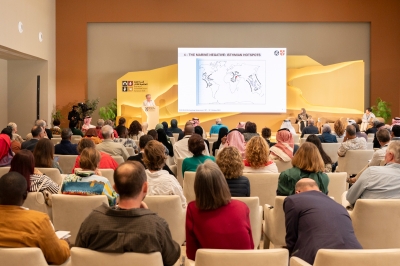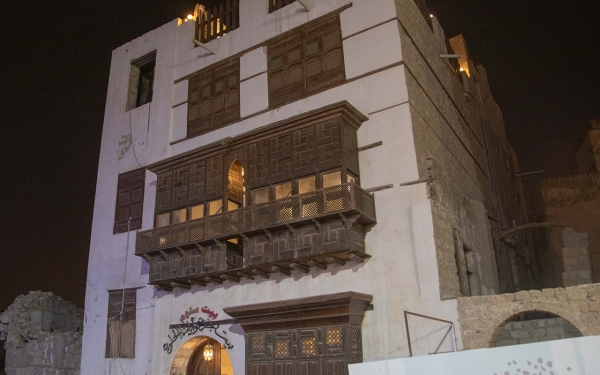
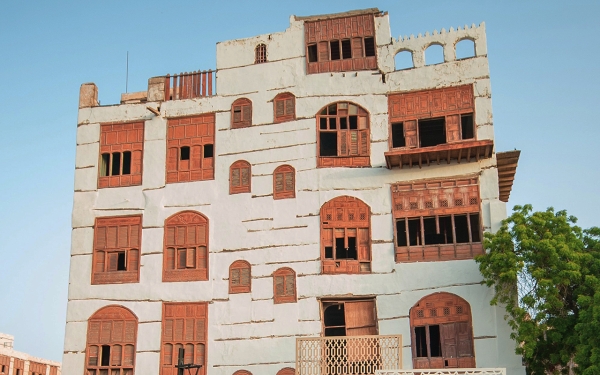
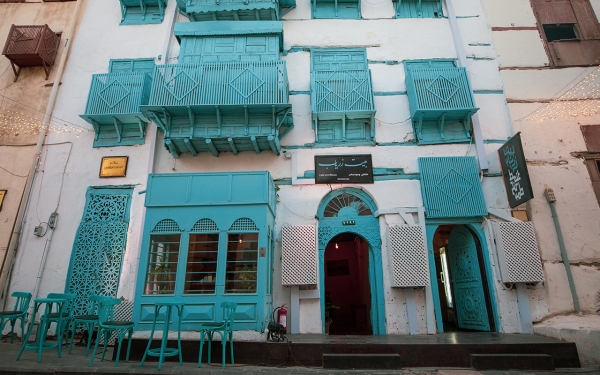
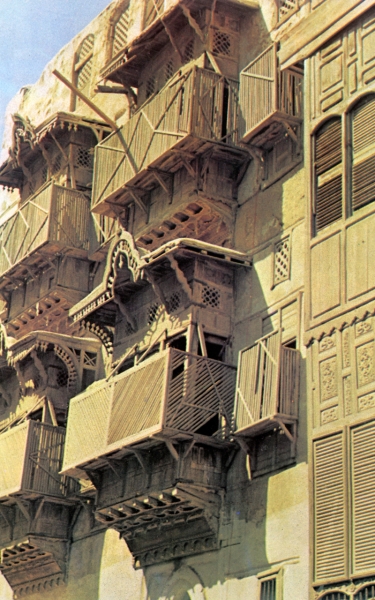
Al-Rawashin are the projecting windows or balconies made of wooden panels used to cover the exterior openings of houses. They are a characteristic feature of the ancient Hijazi architectural style in the cities of Jeddah, Makkah al-Mukarramah, Al-Madinah al-Munawwarah, Yanbu, and Taif in the Kingdom of Saudi Arabia.
The manufacturing of "al-Rawashin" was known in the twelfth century as a way to mitigate high temperatures. Its artistic technique allowed outside air to enter the house and provide natural cooling.
Al-Rawashin Uses
In the past, "al-Rawashin" were utilized as part of the evolution of Islamic architecture and arts for various reasons. They served as windows, allowing sunlight to enter, curtains to regulate light, a piece of furniture, and a vital component of the house's ventilation system. Sometimes, they served as room extensions above the neighboring street. The exterior cover of "al-Rawashin" allows for looking outside while maintaining privacy within the room. It provides the flexibility to fully or partially open the "qallalib" and control the angle of view, lighting intensity, glare, airflow, and speed.
Often, "al-Rawashin" are accompanied by attached benches outside the house, made of stone or brick, commonly known as "Dekka." These benches have a height not exceeding sixty cm and are the same width as the house wall. These benches primarily serve as seating for older family members and other household members, providing a view through the "al-Rawashin" across the bench.
Types of al-Rawashin
In Saudi Arabian architecture, "al-Rawashin" are divided into three types. The first type is called "al-Masmat," which protrudes slightly forward from the wall it is attached to. This style usually lacks prominent engravings and appears as a wooden covering, often extending from the top of the house down to its foundation and ground-level entrance. It is the simplest of the three types, typically found on one of the exterior sides near the house's entrance. Within its frame, it contains rectangular or arched windows filled with intricately carved iron bars. In its upper levels, these rectangular-shaped windows indicate the beginning of each house floor. Most "al-Masmat" designs do not feature a crown or canopy above the "al-Rawashin."
The second type is the "al-Bariz" (projected style), distinguished by more intricate geometric patterns and decorations. This meticulously crafted work is typically placed above the entrances of houses, giving an elegant appearance with its ornate cables and decorative elements. Typically, this particular design is constructed either as a series of continuous units that occupy the entire upper floor space or as a vertical arrangement of distinct units, each with its own unique design on every level of the building. The "al-Rawashin" structures are embellished with vertical architectural embellishments, usually in the form of a crown or a hollowed canopy situated at the top of the building.
The third type is "Roshan," with a balcony. It consists of separate units assembled to form a projection on the extended part of the house's facade, which is known as a balcony. However, divisions, lattice screens, and openings vary more in this type. This type of structure consists of a shade or canopy that extends and leans outward or covers the area flatly. The size, shape, and additional features of these shades or canopies may vary from one house to another.
Al-Rawashin colors
"Al-Rawashin" are characterized by three colors: wooden, shades of brown, and green. They feature aesthetic design units that stand out on the walls of buildings, overlooking the street or central courtyard. These units are supported by protruding wooden cables, showcasing craftsmanship through intricate wooden works in the interlocking sections and window frames. They often consist of small lattice screens.
Al-Rawashin in Makkah-al Mukarramah Province
Al-Rawashin in Makkah-al Mukarramah Province stands out as the tallest and largest of their kind in the Islamic world. They are arranged in stacked rows, often extending from the ground floor to the upper levels or horizontally encircling the upper floors to cover the entire façade of the building.
The historical district of Jeddah preserves the timeless charm of traditional architecture in the alleys of al-Sham, al-Mazloum, al-Bahr, and al-Yemen. The al-Rawashin windows remain witnesses to the authenticity of the ancient Hijazi architectural style, adding a touch of heritage and history to the area. In recognition of its cultural significance, the historical district of Jeddah was inscribed on UNESCO's World Heritage List in 2014.
Related quizzes
Related articles


